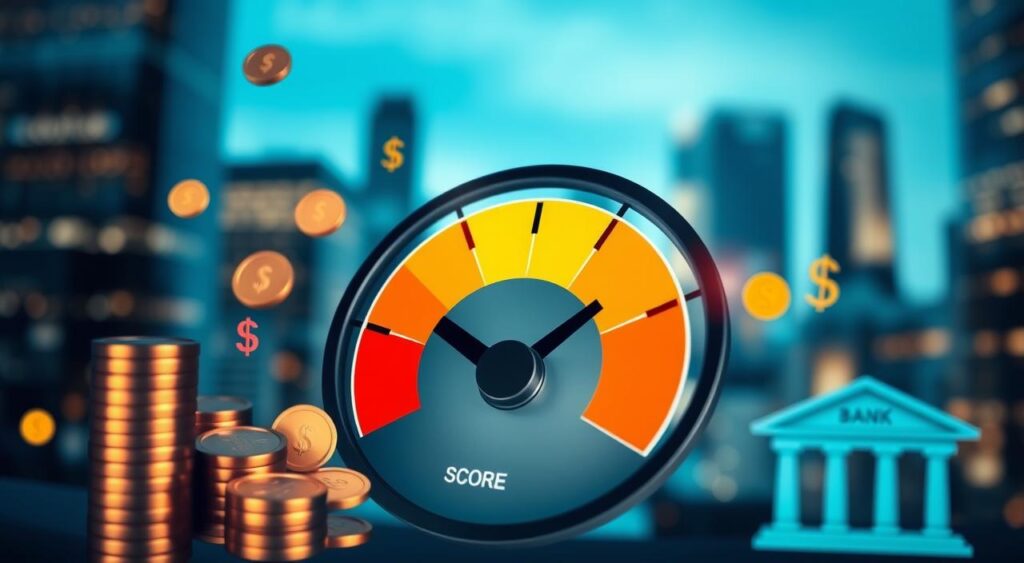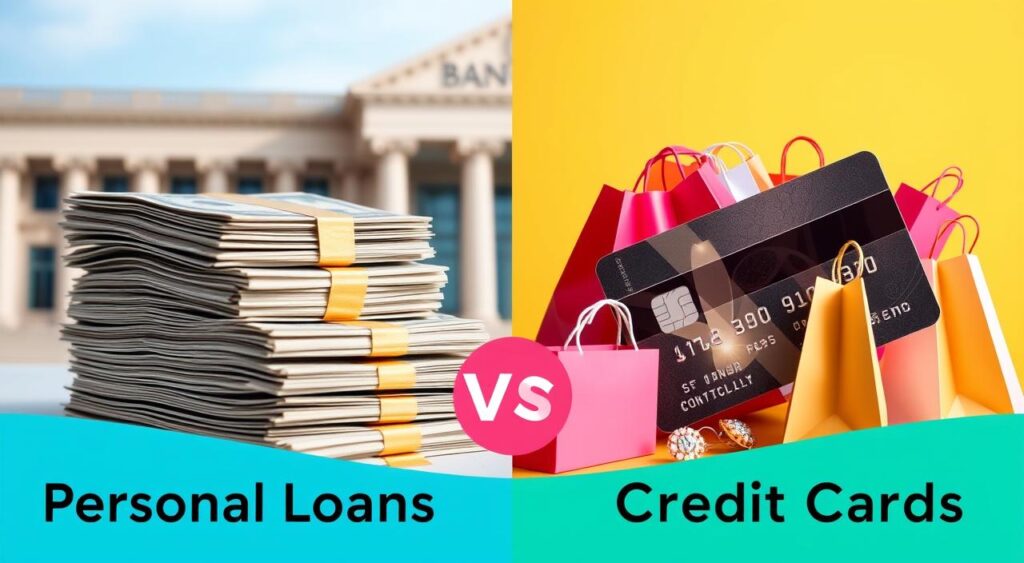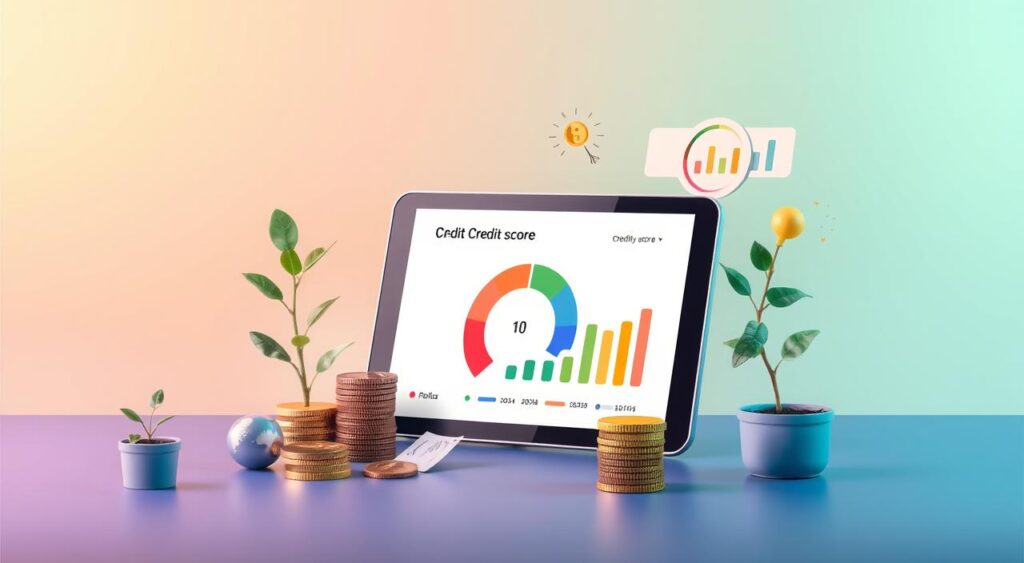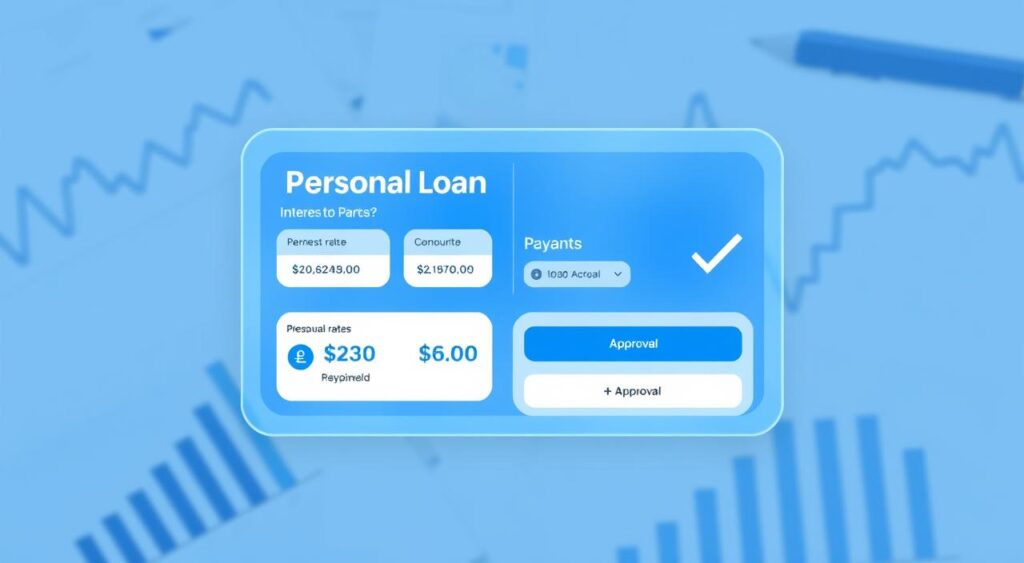Exploring personal loans can seem overwhelming. But, Chase Bank has a special option called “My Chase Loan.” It lets eligible Chase credit card users get a part of their credit line. They can then pay it back over time at a lower interest rate than usual.
So, what is a personal loan, and how does it affect your money? Let’s look into the details.
Key Takeaways
- Chase Bank offers a personal loan option called “My Chase Loan” to eligible customers.
- My Chase Loan allows borrowers to access a portion of their existing credit card’s available credit and repay the loan over a fixed term.
- The minimum loan amount is $500, and the maximum depends on the borrower’s credit profile and card limit.
- There is no application or credit check required for a My Chase Loan – it’s a feature available to eligible Chase cardholders.
- My Chase Loan can be used for a variety of purposes, including large purchases, emergency expenses, and debt consolidation.
What is a Personal Loan?
A personal loan is a type of loan where you get a sum of money upfront. You then pay it back over a set time, usually 2-7 years, with regular payments. Unlike secured loans, personal loans don’t need collateral. They come with fixed interest rates, set monthly payments, and can range from $1,000 to $100,000.
Definition and Key Features
Personal loans are a common financial tool with many benefits. They are unsecured loans that give you a lump sum to repay over 2-7 years with fixed payments. They don’t need collateral, making them easier to get for more people.
Purposes of Personal Loans
- Financing large purchases, such as home renovations or major appliances
- Covering unexpected expenses, like medical bills or emergency repairs
- Consolidating multiple debts into a single, potentially lower-interest payment
- Funding important life events, such as weddings or educational expenses
- Improving credit scores by diversifying the types of credit in a borrower’s portfolio
Personal loans are a flexible and easy way to get the money you need. By knowing what personal loans are, their features, and uses, you can decide if they’re right for you.
| Types of Personal Loans | Typical Loan Amounts | Repayment Terms |
|---|---|---|
| Unsecured Personal Loans | $1,000 to $100,000 | 2 to 7 years |
| Secured Personal Loans | $1,000 to $100,000 | 2 to 7 years |
| Debt Consolidation Loans | $5,000 to $100,000 | 2 to 7 years |
“Personal loans offer a flexible and convenient way for borrowers to access the financing they need for a variety of purposes.”
Credit Score Requirements for Personal Loans
Your credit score is key when you want a personal loan. Lenders want to see a VantageScore of at least 660 or a FICO score around 670. This is to qualify. Those with better scores might get bigger loans and lower interest rates.
But, even with lower scores, you can still get a loan. It might not be as good, though. For instance, scores between 300-600 or 200-579 are seen as “bad credit.”
Remember, the exact score needed can change based on the lender and the loan type. Some might be more flexible, while others are stricter. Your income, debt, and job history also matter.

To boost your loan chances, focus on improving your credit score. Pay bills on time, lower your credit use, and fix any credit report mistakes.
Knowing what credit scores lenders want can help you prepare. This way, you’re more likely to get the loan you need.
Impact of Personal Loans on Credit Scores
Personal loans can have both good and bad effects on your credit score. On one side, making timely payments can improve your credit. But, the loan application and missed payments can also lower it.
How Personal Loans Build Credit
Personal loans add variety to your credit mix, which is 10% of your FICO score. They show you can handle different credit types. Also, regular, on-time payments boost your payment history, which is 35% of your score.
How Personal Loans Can Hurt Credit
Getting a personal loan means a hard inquiry, which can drop your score by up to 10 points. Missing payments or defaulting can hurt your score even more, by 100 points or more. Late or missed payments stay on your report for up to seven years.
In short, personal loans can be good or bad for your credit score. They can add variety and show you’re responsible with payments. But, the initial inquiry and missed payments can harm your score. It’s important to think carefully and manage your loan well to get the most benefits and avoid the downsides.

When to Apply for a Personal Loan
Understanding personal finance can be complex. Knowing when to get a personal loan is crucial. These loans help with big purchases, unexpected costs, or combining high-interest debts. It’s key to consider the pros and cons of personal loans versus credit cards for your financial health.
Personal loans are great when you need more money than your credit cards allow. They’re perfect for big expenses like home improvements, medical bills, or even a dream trip.
They’re also good for combining several high-interest debts into one. This can lower your interest payments and make managing your finances easier.
| Reasons to Apply for a Personal Loan | Reasons to Use a Credit Card |
|---|---|
| Financing a large purchase | Smaller, everyday expenses |
| Covering unexpected expenses | Building credit history |
| Consolidating high-interest debts | Earning rewards or cash back |
Choosing between a personal loan and a credit card depends on several factors. Look at interest rates, repayment terms, and your financial health. Personal loans might have lower rates and fixed payments. Credit cards are better for short-term needs and can help build credit. Think about your goals and situation to pick the best choice for you.

Borrowing vs. Using Credit Cards
Choosing between a personal loan and a credit card for a big purchase involves several key points. Personal loans usually have fixed interest rates and set repayment terms. This makes it easier to budget. They also let you borrow a larger amount than credit cards.
Credit cards are better for small, daily expenses. They offer revolving credit and might give rewards or cash back. It’s important to think about your financial situation, the size of the purchase, and your payment ability. This will help decide if a personal loan or credit card is best.
Comparing Personal Loans and Credit Cards
| Feature | Personal Loan | Credit Card |
|---|---|---|
| Interest Rates | Average 10.73% – 15.50% APR | Average 20.76% APR |
| Loan Amounts | $1,000 to $100,000 | Dependent on credit limit |
| Repayment Terms | 24 to 144 months | Revolving credit |
| Fees | Origination fees (2.9% – 8%) | Late fees, annual fees, etc. |
The choice between a personal loan vs. credit card depends on your financial situation and why you’re borrowing. Consider the loan amount, repayment period, and your ability to make regular payments. This will help you decide when to use a personal loan vs. credit card.

“Personal loans typically offer lower interest rates than credit cards, making them a more cost-effective option for larger purchases or debt consolidation.”
Monitoring Your Credit Score
Keeping your credit in good shape is key, whether you’re looking at personal loans or big credit card buys. By keeping an eye on your credit score, you can spot changes and make smart money moves. Chase Bank’s free service, Chase Credit Journey, lets you track your score and manage your finances better.
Chase Credit Journey gives you your VantageScore® 3.0 credit score, based on your Experian™ report, anytime you want, without hurting your credit. It watches all your accounts, not just Chase ones, to warn you of score changes like new inquiries or account openings.
This service also checks for identity fraud, alerting you to any suspicious activity. It’s a full package to help you keep your credit healthy and make smart money choices.
Signing up for Chase Credit Journey is simple through the Chase Mobile® app or website. Once you’re in, you get your free Experian report and tools to understand and manage your credit. If you need help, Chase’s support team is ready 24/7.
Keeping an eye on your credit is crucial today. With Chase Bank’s free tools, you can stay on top of your score and keep it strong. This helps you reach your financial goals and avoid credit problems later.

| Feature | Description |
|---|---|
| Credit Score Monitoring | Chase Credit Journey provides access to your VantageScore® 3.0 credit score based on your Experian™ credit report, with no impact on your credit. |
| Credit Report Monitoring | The service monitors all your accounts, not just those with Chase, to alert you of changes that could affect your credit score. |
| Identity Monitoring | Chase Credit Journey includes identity monitoring to detect any suspicious activity related to your accounts or Social Security number. |
| Enrollment and Support | You can enroll in Chase Credit Journey through the Chase Mobile® app or the Chase website, and receive support from Chase’s 24/7 customer service team. |
Using Chase Bank’s free credit monitoring services helps you stay updated on your score. This way, you can make better financial choices. Remember, keeping an eye on your credit is key to a healthy profile and avoiding future problems.
What is My Chase Loan?
My Chase Loan is a feature from Chase Bank for credit card users. It lets them use part of their card’s credit as a personal loan. This is done without needing a separate application or credit check.
How My Chase Loan Works
Eligible Chase cardholders can pick a loan amount (at least $500) and a repayment term. This term is usually 12 to 24 months. The money is then put into the borrower’s bank account in 1-2 business days.
The loan is paid back through regular monthly credit card payments. The APR is fixed and often lower than the standard purchase APR.
Some key features of My Chase Loan include:
- No separate application or credit check required
- Minimum loan amount of $500
- Repayment terms from 12 to 24 months
- Fixed APR lower than standard purchase APR
- Funds deposited into bank account within 1-2 business days
- Ability to continue making purchases on the Chase credit card
- No fees, including origination or early payoff fees
The maximum loan amount depends on monthly spending, creditworthiness, and account details. Customers can have up to 10 active My Chase Loan plans at once.

My Chase Loan is a convenient option for Chase credit card users. It allows them to get funds easily without a separate application or credit check. This makes it a useful financing choice for those who qualify.
Interest Rates and Payments for My Chase Loan
Understanding interest rates and monthly payments for a My Chase Loan is crucial. The interest rate is fixed and depends on your credit score and loan amount. Usually, the APR on a My Chase Loan is lower than your Chase credit card’s purchase APR.
The monthly payment for a My Chase Loan is based on the loan amount and repayment term. The loan balance and interest are added to your Chase credit card statement. You can pay your My Chase Loan by simply paying your credit card bill each month. This makes repaying the loan easy and convenient.
| Metric | My Chase Loan | My Chase Plan |
|---|---|---|
| APR | Relatively high, variable rate adjusting with changes in the prime rate | 20.64% (1.72% of each purchase transaction on an annual basis) |
| Impact on Credit Score | Balances affect credit utilization and credit scores | Balances affect credit utilization and credit scores |
| Availability | Subject to change and can be withdrawn at any time by Chase | Subject to change and can be withdrawn at any time by Chase |
| Approval Criteria | Creditworthiness, credit limit, and past account behavior | Creditworthiness, credit limit, and past account behavior |
It’s vital to review the terms and conditions of a My Chase Loan carefully. This includes the interest rates and monthly payments. By understanding these details, you can ensure the loan fits your financial goals and capabilities. This knowledge helps you manage your repayment effectively.
Fees Associated with My Chase Loan
When it comes to my chase loan fees, the good news is that there are no origination or early payoff fees. Borrowers can pay off their my chase loan early without any penalties. They just need to pay their credit card statement in full each month.
However, regular credit card account fees may still apply. This includes late payment fees if the borrower misses a monthly payment. The my chase loan fees can vary, so it’s important to review the details before signing up.
| Fee Type | Description | Amount |
|---|---|---|
| Origination Fee | No origination fee is charged for my chase loan | $0 |
| Early Payoff Fee | No penalty for paying off my chase loan early | $0 |
| Late Payment Fee | Regular credit card account fees may apply for late payments | Varies |
The lack of my chase loan fees for origination and early payoff is a big plus. It helps borrowers save money and manage their debt better. But, it’s key to make monthly payments on time to avoid late fees and other charges.
How to Sign Up for My Chase Loan
Eligible Chase credit card customers can find My Chase Loan offers online at chase.com or in the Chase Mobile app. The sign-up is easy, with just three steps. First, choose the loan amount (at least $500). Then, pick your repayment term. Finally, the money will be deposited into your bank account.
Eligibility Criteria
To get a My Chase Loan, you need to meet certain criteria. This includes your credit score, credit limit, and your history with Chase. Remember, you might not qualify right away, especially in the first 180 days.
Here are some important details about how to get my chase loan and my chase loan eligibility requirements:
- No credit check is required for My Chase Loan.
- The APR for My Chase Loan is often lower than your card’s standard APR.
- There are no origination or early payoff fees with My Chase Loan.
- My Chase Loan only uses a part of your card’s credit limit.
- The minimum loan amount is $500, and you can get the funds in 1-2 business days.
To see if you’re eligible, just log in to your account on chase.com or the Chase Mobile app. The loan amount you can get depends on your spending, credit score, and other account details.
“My Chase Loan offers a convenient and flexible way for eligible Chase cardholders to access funds, with a streamlined application process and competitive rates.”
Pros and Cons of My Chase Loan
Understanding the good and bad points of personal loans is key to smart financial choices. My Chase Loan, from Chase Bank, is one such option. Let’s explore the pros and cons of this loan.
Advantages of My Chase Loan
- No credit check required: My Chase Loan lets you borrow without a traditional credit check. This makes it easier for more people to get a loan.
- No origination fees: Unlike many loans, My Chase Loan doesn’t charge setup fees. This saves you money right away.
- Seamless repayment: Repaying the loan is easy because it’s added to your Chase credit card bill. This makes it simple and convenient.
- Early payoff without penalties: Paying off the loan early doesn’t cost you extra. This gives you more freedom.
Disadvantages of My Chase Loan
My Chase Loan has some benefits, but there are also downsides to think about:
- Impact on credit utilization: Using a My Chase Loan reduces your available credit. This can hurt your credit score.
- Higher interest rates: My Chase Loan often has a variable interest rate. This might be higher than a regular personal loan, especially if your credit card’s APR is lower.
- Potential for overspending: Easy access to more credit might lead to spending too much. This can increase your debt.
Whether or not to use My Chase Loan depends on your financial situation and goals. Think about how it fits into your spending and credit management plans. This will help you decide if it’s the best choice for you.
Does Chase Bank Offer Personal Loans
Chase Bank is a big name in the U.S. finance world. But, it doesn’t give out personal loans. Instead, it offers many other services like credit cards, mortgages, auto loans, and home equity lines of credit.
Other big U.S. banks like U.S. Bank, Citi, and Wells Fargo do offer personal loans. These loans have different amounts and interest rates. Some credit unions like Service Credit Union, PenFed Credit Union, and Alliant Credit Union also have personal loans. They have limits on interest rates and need you to be a member.
For those looking for personal loan options, there are online lenders too. LightStream, SoFi, and Avant are some examples. They offer various loan amounts and interest rates to fit different financial needs.
| Lender | Loan Amounts | Interest Rates | Loan Terms |
|---|---|---|---|
| U.S. Bank | $1,000 – $50,000 | 7.24% – 18.00% APR | 12 – 84 months |
| Citi | $2,000 – $50,000 | 7.99% – 23.99% APR | 12 – 60 months |
| Wells Fargo | $3,000 – $100,000 | 5.99% – 24.49% APR | 12 – 84 months |
Chase Bank might not have personal loans, but it has lots of other financial products. If you need a personal loan, you can check out what other banks, credit unions, and online lenders offer. This way, you can find what suits your financial situation best.
Flexibility of My Chase Loan
My Chase Loan stands out for its flexibility, making borrowing easy for Chase cardholders. It uses the credit on your card, skipping the need for extra paperwork or checks. This makes getting a loan simple and quick.
You can pick how much you want to borrow and how long to pay it back. This flexibility is great for big purchases or unexpected bills. Plus, you can still use your card for other things, as long as you have credit left.
One of the best parts is you can pay off the loan early without any extra fees. This lets you pay off the loan when you can, whether it’s sooner or later. It gives you more control over your finances.
“My Chase Loan has provided me with the flexibility I needed to address a sudden financial need without disrupting my overall credit card usage. The ability to choose the loan amount and repayment term, as well as the option to pay it off early, has been a game-changer for my financial planning.”
In short, My Chase Loan’s flexibility is a big reason people like it. It works with your existing card, lets you set your own terms, and doesn’t charge for early payoffs. This makes it a better choice than traditional loans, giving you more control over your money.
| Feature | Details |
|---|---|
| Loan Amount | Flexible, based on available credit |
| Repayment Term | Customizable, from 6 to 60 months |
| Early Repayment | No penalties for early payoff |
| Credit Card Usage | Ability to continue using credit card for purchases |
Comparing My Chase Loan to Traditional Loans
Borrowers have two main options for personal financing: My Chase Loan and traditional personal loans. Both offer funds, but they differ in key ways.
My Chase Loan stands out because it doesn’t need a separate application or credit check. This is great for Chase customers who need money fast and easily. Also, My Chase Loan doesn’t have origination fees, unlike many other loans.
Another unique feature of My Chase Loan is how you pay it back. You can add your loan payments to your regular credit card bill. This makes paying back the loan simple and easy.
But, traditional personal loans might offer more money, up to $40,000 to $50,000. They also might have lower interest rates for those with excellent credit.
| Feature | My Chase Loan | Traditional Personal Loans |
|---|---|---|
| Application Process | Integrated with Chase credit card account, no separate application | Separate application and credit check required |
| Origination Fees | No origination fees | Origination fees common |
| Repayment | Integrated with monthly credit card bill | Separate loan account and payment schedule |
| Maximum Loan Amount | Varies based on credit limit | Typically up to $40,000 – $50,000 |
| Interest Rates | Varies based on creditworthiness | May be lower for borrowers with excellent credit |
The choice between My Chase Loan and a traditional personal loan depends on your financial needs and credit. Both can help, but they suit different people in different ways.
Repayment Options for My Chase Loan
Repaying a My Chase Loan is easy and stress-free. The loan amount and interest are added to your regular credit card bill. You can pay the minimum each month to cover the loan and other card charges.
My Chase Loan stands out for its flexibility in early payoff. You can pay off the loan anytime without penalty by paying your card in full. This lets you manage your repayment based on your finances and goals, like paying off early to save on interest.
| Repayment Option | Description |
|---|---|
| my chase loan monthly payments | The loan amount and interest are included in the regular monthly credit card bill, allowing customers to make a single payment to cover both the loan and other card transactions. |
| paying off my chase loan early | Borrowers can pay off the full my chase loan repayment balance at any time by paying the credit card statement in full, without facing any early payoff penalties. |
My Chase Loan’s flexible repayment options help customers manage their debt. Whether you prefer regular payments or early payoff, My Chase Loan makes it easy. It’s a convenient way to handle personal finances.
Conclusion
Chase Bank offers personal loans through My Chase Loan. This feature lets Chase credit cardholders use part of their credit for a fixed-term loan. No extra application or credit check is needed.
The loan amounts, repayment terms, and interest rates can be tailored to fit your needs. Your monthly payments are added to your regular credit card bill. This makes managing your finances easier.
My Chase Loan might not have the biggest loan sizes or the lowest interest rates. But it’s a flexible and easy way to get financing. It’s perfect for big purchases, emergencies, or paying off debt using your available credit.
This feature is a convenient solution for Chase customers. It helps them get personal financing without the trouble of a separate application.
Chase Bank’s personal loan options, including My Chase Loan, show the bank’s dedication to offering innovative financial solutions. They aim to meet the varied needs of their customers. With its long history, resources, and large customer base, Chase keeps improving its products. This helps individuals and businesses reach their financial goals.
FAQ
What is a personal loan?
A personal loan is money given by a lender that you pay back over time. You usually pay it back in 2-7 years with set payments. It’s not secured like a mortgage or car loan.
What are the key features of personal loans?
Personal loans have fixed rates and payments. You can borrow from $1,000 to $100,000. They’re good for big buys, emergencies, or paying off other debts.
What credit score is required for a personal loan?
You need a VantageScore of 660 or a FICO score of 670 to qualify. A better score means you can borrow more and get lower rates.
How do personal loans impact credit scores?
Personal loans can help your credit score in some ways. They add to your credit mix and help with payment history if you pay on time. But, applying first can lower your score by 5 points.
When is it appropriate to apply for a personal loan?
Apply for a personal loan for big purchases, unexpected bills, or to consolidate debts. They’re better than credit cards for big amounts or emergencies.
How do I choose between a personal loan or a credit card?
Think about interest rates, repayment terms, and your finances. Personal loans have fixed rates and terms, while credit cards are for small, everyday buys.
How can I monitor my credit score?
Use a free service like Chase Credit Journey to track your score. It gives insights for better financial choices.
What is My Chase Loan?
My Chase Loan lets eligible Chase cardholders use part of their credit for a loan. No extra application or credit check needed.
How does the interest rate and repayment work for My Chase Loan?
My Chase Loan has a fixed interest rate, often lower than your card’s APR. Your monthly payment is based on the loan amount and term. It’s included in your card’s monthly statement.
Are there any fees associated with My Chase Loan?
No origination or early payoff fees for My Chase Loan. But, regular card fees like late payment fees still apply if you miss payments.
How do I sign up for My Chase Loan?
Eligible Chase cardholders can sign up online at chase.com or the Chase Mobile app. It’s a three-step process: choose the loan amount, select the term, and get the funds in your bank account.
What are the pros and cons of My Chase Loan?
My Chase Loan has benefits like no credit check or fees. But, it uses part of your credit limit, affecting future purchases.
Does Chase Bank offer personal loans?
Yes, Chase Bank offers personal loans through My Chase Loan. It lets Chase cardholders use their credit for a loan without a separate application or credit check.
How is My Chase Loan different from traditional personal loans?
My Chase Loan doesn’t need a separate application or credit check. It also has no origination fees. But, traditional loans might offer more money and lower rates for good credit.
How do I repay a My Chase Loan?
Repaying My Chase Loan is easy. It’s included in your regular card bill. You can pay the minimum or the full amount anytime to pay off the loan.

